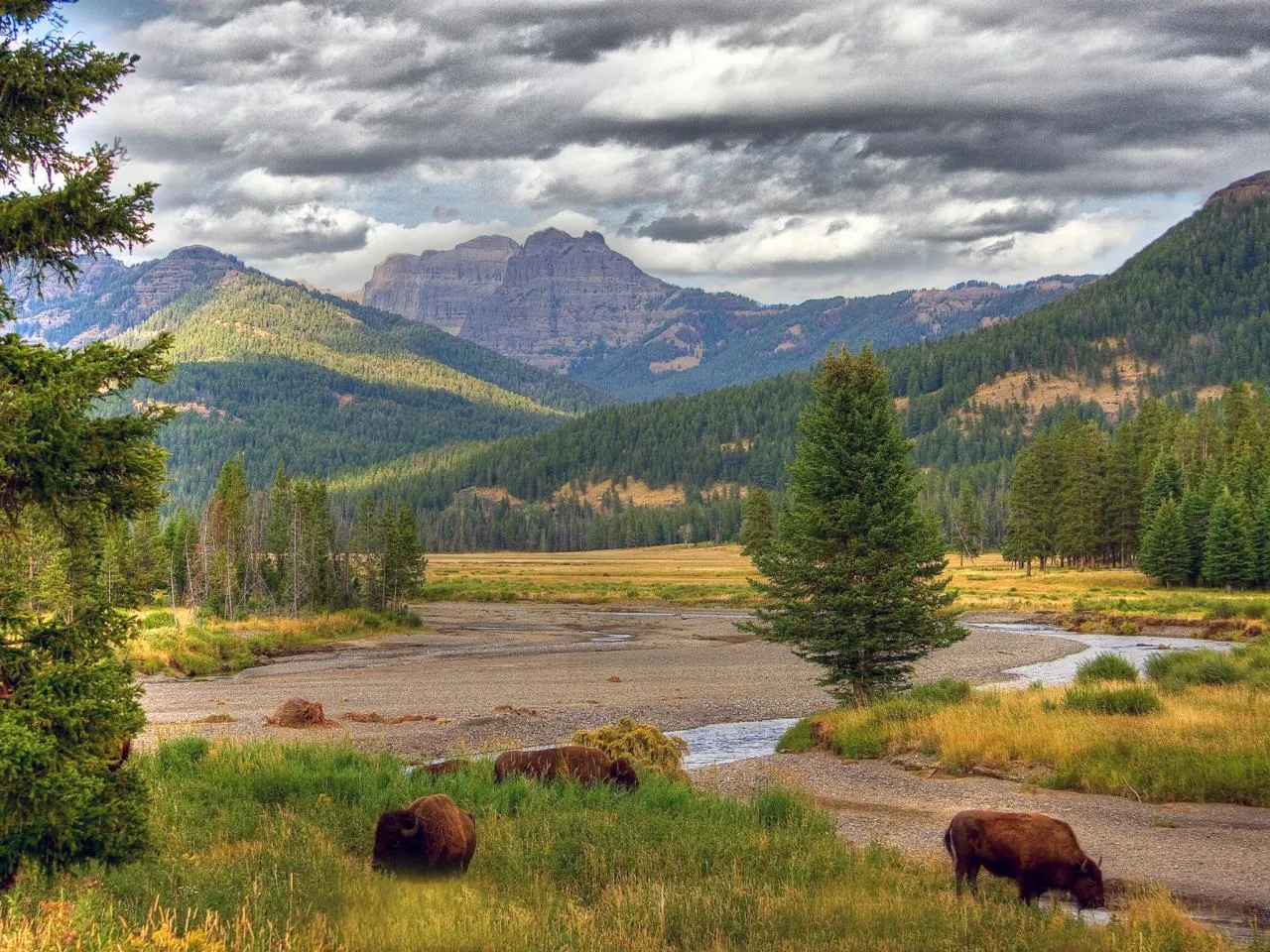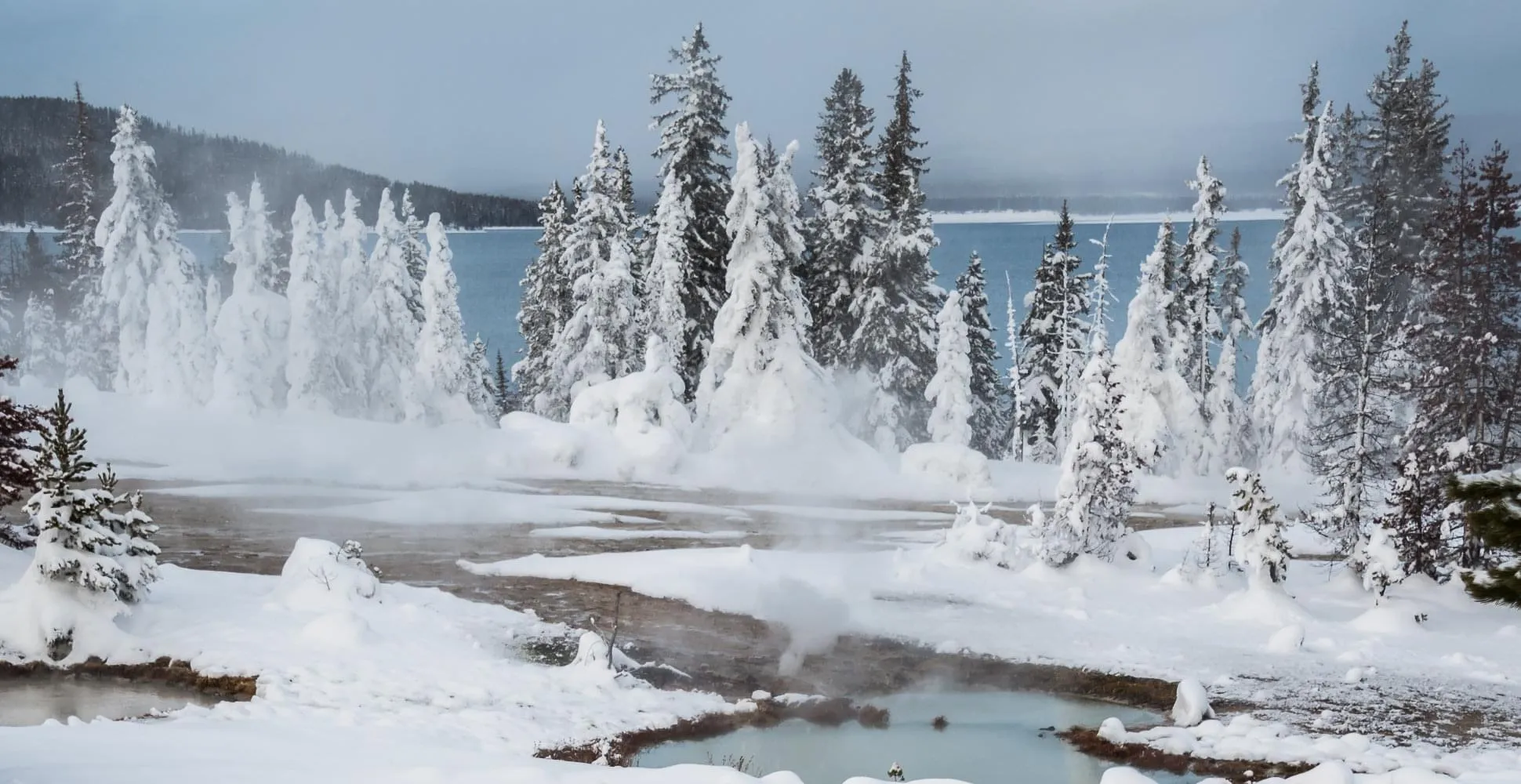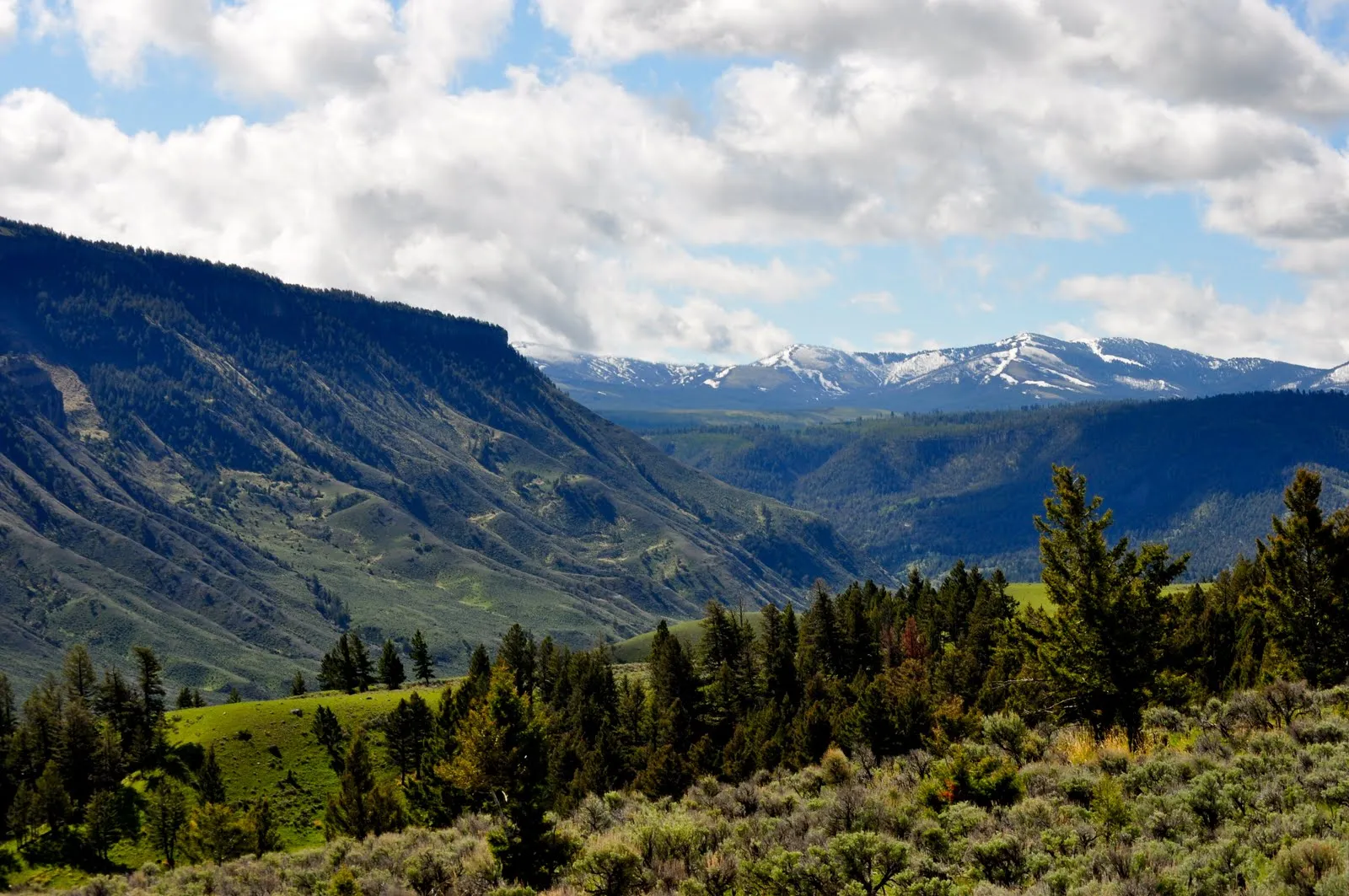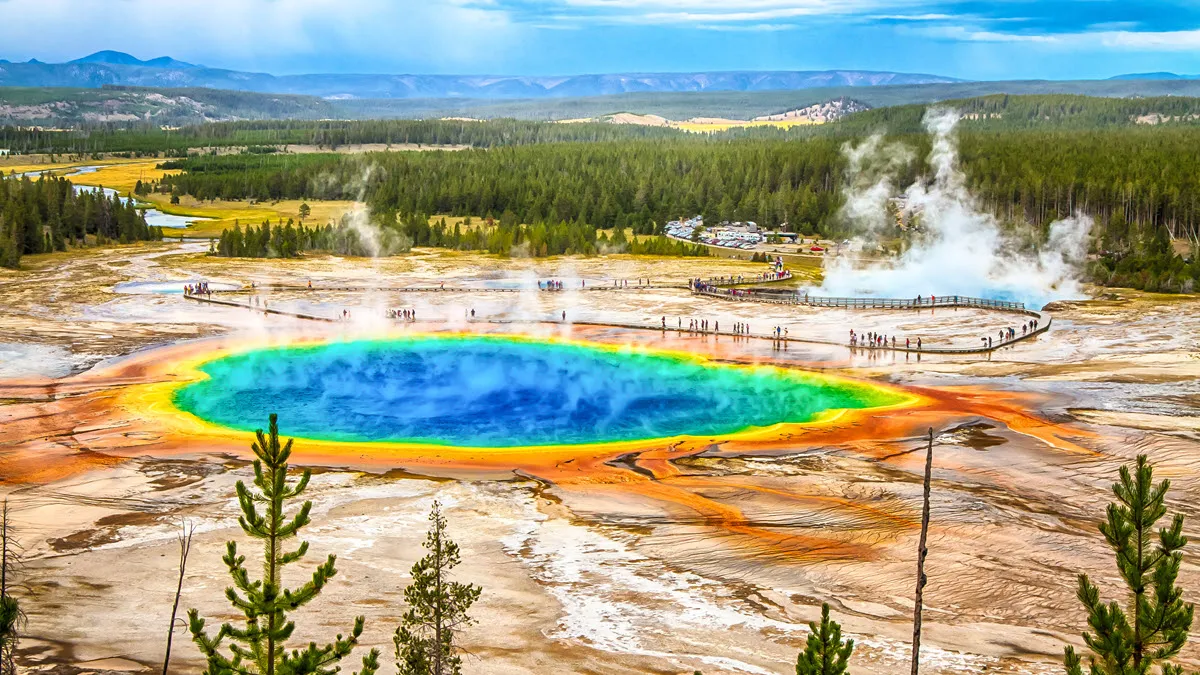Yellowstone, the world’s first national park, is not only a symbol of America but also a sanctuary for those who love wild nature. It is home to unique geothermal wonders, majestic landscapes, and the most diverse ecosystems on the planet. Amidst this breathtaking beauty, the Yellowstone gray wolf stands out as a powerful and captivating symbol, urging photography and exploration enthusiasts to capture the vivid moments of this rare wildlife species. Join “Du lịch khắp thế gian” on a Yellowstone wolf photography journey, an experience that is not just travel, but also a deep connection with nature and the wild instinct within each of us.
Yellowstone National Park – A Wildlife Paradise for Nature and Photography Lovers
Established in 1872, Yellowstone is a testament to humanity’s far-sighted vision for nature conservation. Spanning nearly 9,000 km², this national park stretches across three states—Wyoming, Montana, and Idaho—encompassing a magical land of towering mountains, vast pine forests, boundless meadows, and countless lakes and rivers. Yellowstone is renowned for over 10,000 geothermal features, including the famous Old Faithful geyser, the vibrant Grand Prismatic Spring, and mysterious bubbling mud pots.

Majestic Yellowstone National Park
Moreover, Yellowstone is a shared home for countless species of wild flora and fauna. From mighty bison herds, graceful elk, and majestic grizzly bears to elusive gray wolves and cunning red foxes, all create a vivid picture of the pristine natural world. For photographers, Yellowstone is a treasure trove, where every angle can capture unique beauty and precious moments. In particular, the Yellowstone wolf photography experience is a thrilling challenge, demanding patience, skill, and luck, but the reward is invaluable when you can capture authentic and emotional images of this wildlife species in their natural habitat.
Yellowstone Gray Wolves – Symbols of Wilderness and Ideal Photography Subjects
Gray wolves once disappeared from Yellowstone in the 1920s due to government predator control policies. However, in 1995, a gray wolf reintroduction program was implemented, marking a significant turning point in the restoration of the park’s ecosystem. The return of gray wolves not only enriched biodiversity but also helped balance the ecosystem, controlling populations of deer, elk, and other herbivores, bringing new vitality to Yellowstone.

Gray Wolf in Yellowstone National Park
Today, Yellowstone is one of the best places in the world to observe and photograph gray wolves in their natural environment. This species not only possesses wild, powerful beauty but also complex social behaviors, creating exciting and unexpected moments for photographers. Yellowstone wolf photography is not just about capturing images, but also an opportunity to learn about their habits, pack life, and role in the ecosystem. However, this is also a significant challenge, requiring thorough preparation, knowledge of locations, timing, and wildlife photography skills.
Tips for Successful Yellowstone Wolf Photography
To have a successful and memorable Yellowstone wolf photography experience, you need to equip yourself with the necessary knowledge and skills. Here are some helpful tips:
Ideal Timing
Winter and early spring (from December to March) are often considered the best times for Yellowstone wolf photography. At this time, snow blankets the landscape, creating a stunning backdrop and making gray wolves easier to spot against the white snow. Moreover, winter is the breeding season for gray wolves, giving you a chance to observe wolf packs more actively, as well as moments of wolf mothers caring for their pups.

Winter in Yellowstone
However, spring (April – June) and autumn (September – November) are also good choices. Spring brings new life, with plants budding and wildlife becoming more active. Autumn is captivating with the vibrant yellow and red colors of maple leaves, creating a beautiful backdrop for wolf photos. Summer (June – September) has warm, pleasant weather, but gray wolves tend to move to higher elevations to escape the heat, making observation more difficult.
Wolf Sighting and Photography Locations
Lamar Valley and Hayden Valley, nicknamed the “Serengeti of North America,” are two of the most famous locations for Yellowstone wolf sighting and photography. Lamar Valley is particularly renowned for its high density of gray wolves, where you can easily spot them hunting, playing, or simply resting on the hills. Hayden Valley is also home to many wolf packs, along with other wildlife such as bison, elk, and grizzly bears.

The Lamar Valley Wilderness
In addition, you can seek information from Yellowstone visitor centers, park rangers, or experienced wolf photographers for more potential locations. Remember that gray wolves are wild animals; finding and observing them requires patience and luck.
Essential Equipment
For Yellowstone wolf photography, you need to prepare adequate equipment, especially specialized photography gear.
- Camera: A DSLR or mirrorless camera with high-speed continuous shooting capability and good ISO performance is ideal.
- Lens: A telephoto lens with a focal length of 400mm or longer is mandatory for photographing wolves from a safe distance. Versatile zoom lenses like 200-500mm or 150-600mm are very useful.
- Tripod: A sturdy tripod is essential to keep the camera stable when shooting with long telephoto lenses, especially in low light conditions.
- Binoculars: High-quality binoculars help you easily spot and observe wolves from afar before approaching for photography.
- Clothing: Warm, waterproof, and windproof clothing is crucial, especially if you are photographing in winter. Dress in layers to easily adjust to changing temperatures.
- Other accessories: Gloves, beanie, scarf, hiking boots, thermos, snacks, spare batteries, spare memory cards, waterproof camera bag, etc.
Skills and Experience in Wolf Photography
Wolf photography is not just about having good equipment, but also requires observation skills, knowledge of wolf behavior, and patience.
- Learn about gray wolves: Researching the behavior, habitat, diet, and habits of gray wolves will increase your chances of finding them and predicting their behavior to capture beautiful moments.
- Patience and observation: Gray wolves are wild animals; they do not appear on schedule. You need to wait patiently and carefully observe the surrounding environment to spot their signs.
- Tracking skills: Learning to recognize wolf tracks, distinguish them from the tracks of other animals, as well as other signs such as scat, scratches, howls, etc., will help you pinpoint areas with wolves.
- Wildlife photography skills: Master wildlife photography techniques such as fast focusing, choosing appropriate shutter speeds, and using flexible aperture and ISO to adapt to changing lighting conditions.
Safety and Ethics in Wolf Photography
Safety and ethics are two paramount factors in Yellowstone wolf photography.
- Maintain a safe distance: Always maintain a safe distance from gray wolves and other wildlife. Do not approach too closely, do not feed or disturb them. The recommended minimum safe distance is 100 yards (about 91 meters).
- Comply with national park regulations: Learn and comply with Yellowstone National Park regulations regarding wildlife viewing, permitted access areas, trails, and permitted activities.
- Avoid loud noises: Keep quiet and avoid making loud noises when observing wolves to avoid startling them or altering their natural behavior.
- Do not use bait: Absolutely do not use bait or any form of intervention to manipulate the natural behavior of wolves for photography.
- Respect the environment: Do not litter, do not pollute the environment, maintain general hygiene, and protect the natural landscape of Yellowstone.
Combine Wolf Photography with Yellowstone Exploration
The Yellowstone wolf photography experience will be more complete if you combine it with exploring other highlights of this national park. Do not miss the opportunity to witness the Old Faithful geyser erupting powerfully, admire the vibrant Grand Prismatic Spring, explore the majestic Grand Canyon of the Yellowstone with the beautiful Lower Falls, or cruise on the vast Yellowstone Lake.

Breathtaking Grand Prismatic Spring
Besides, Yellowstone offers countless other exciting activities such as hiking on stunning trails, camping in the wilderness, fishing on rivers and lakes, kayaking, or simply relaxing and enjoying the fresh mountain air.
Conclusion
The Yellowstone wolf photography experience is a challenging but incredibly rewarding journey. It is not just an opportunity to capture impressive moments of a rare wildlife species, but also a chance to immerse yourself in pristine nature, explore the magical beauty of Yellowstone, and feel a deep connection with the natural world. Prepare your gear and plan your Yellowstone wolf photography trip today to discover the wild beauty and experience the wonders that nature bestows. If you want to explore more about traveling in the US and Yellowstone, visit EuroTravel for the best advice and support for your trip.